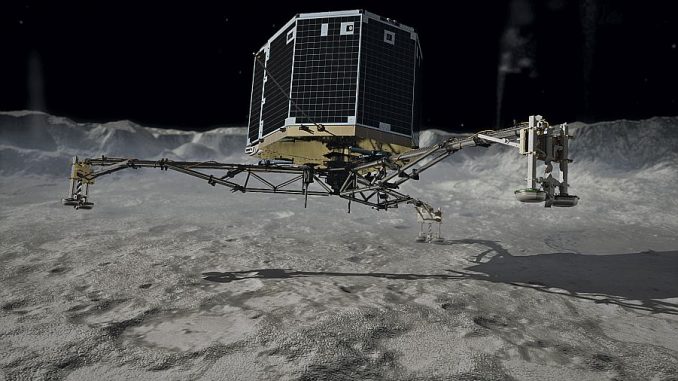
Philae lander has maintained radio silence on the comet 67P/Churyumov-Gerasimenko.
Efforts to contact the Philae lander have failed since its last contact ten days ago. European scientists fear the robot may have moved again after it successfully landed on the 67P/Churyumov-Gerasimenko comet in November.
The historic project by the European Space Agency to land a probe on a comet is still on track, with hopes that Philae might wake up again and start communicating with ground control; a trait of the robot which has been noted in the past.
It is believed the robot is hiding in the shadows hoping to catch a ray of sunlight to recharge its batteries and awaken from her slumber. She was last heard of on July 9 by the European Space Agency. According to reports on Monday, experts and scientists have failed in their efforts to reach her, although they are optimistic about getting surprised with some new data from the Philae lander. The robot is believed to have been displaced by movements on the comet’s surface.
It is hoped she will communicate with Rosetta before July 24, otherwise she might loose her satellite orbiter, for Rosetta has her own duties to perform besides waiting on Philae millions of miles from home.

BYPASS THE CENSORS
Sign up to get unfiltered news delivered straight to your inbox.
You can unsubscribe any time. By subscribing you agree to our Terms of Use
Latest Video
The Guardian reports:
The lander – the first mission to touch down on a comet – initially bounced and landed in a position too shadowy to power its solar panels.
It woke up in June as the comet moved closer to the sun. But the latest data suggests something, possibly a gas emission, may have moved it again.
“The profile of how strongly the sun is falling on which panels has changed from June to July, and this does not seem to be explained by the course of the seasons on the comet alone,” Stephan Ulamec, Philae project manager at the DLR German Aerospace Centre said in a statement.
Philae’s antenna may have been obstructed and one of its transmitters appears to have stopped working, the team said. There was no answer to a command sent to activate Philae’s Romap instrument to determine the comet’s plasma environment and magnetic field.
Communications between Philae and its Rosetta orbiter are also tricky because the increasing amounts of dust thrown off by the comet as it approaches the sun make it hard for the orbiter to stay close to the comet, they added.
Scientists have now sent out a command telling Philae to use only one transmitter and have started moving the orbiter to a safer distance about 105-118 miles (170-190km) from the comet.
Until 24 July, Rosetta will orbit a path that may allow it to contact the lander. After that it will fly over the southern hemisphere of the comet to observe it with its own 11 instruments.
“Philae is obviously still functional, because it sends us data, even if it does so at irregular intervals and at surprising times,” Ulamec said.


